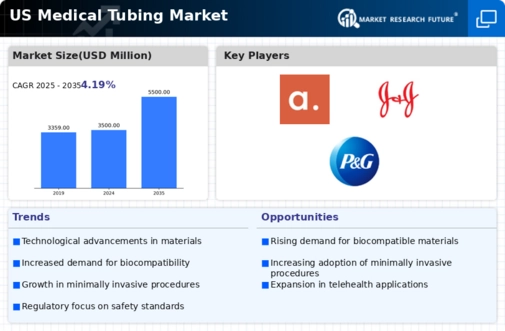Increasing Healthcare Expenditure
The medical tubing market is experiencing growth driven by rising healthcare expenditure in the United States. As healthcare budgets expand, hospitals and clinics are investing more in advanced medical technologies, including high-quality medical tubing. According to recent data, healthcare spending in the US is projected to reach approximately $4.3 trillion by 2025, which indicates a robust demand for medical devices. This increase in funding allows healthcare facilities to upgrade their equipment and improve patient care, thereby boosting the medical tubing market. Furthermore, the shift towards more sophisticated healthcare solutions necessitates the use of specialized tubing for various applications, including drug delivery and fluid management. As a result, the medical tubing market is likely to benefit from this upward trend in healthcare investment.
Growth in Chronic Disease Prevalence
The medical tubing market is significantly influenced by the rising prevalence of chronic diseases in the United States. Conditions such as diabetes, cardiovascular diseases, and respiratory disorders require ongoing medical interventions, which often involve the use of specialized tubing for treatment delivery. The Centers for Disease Control and Prevention (CDC) reports that chronic diseases account for 7 of the 10 leading causes of death in the US, highlighting the urgent need for effective medical solutions. This growing patient population drives demand for medical tubing used in various applications, including intravenous therapy and catheterization. As healthcare providers seek to enhance patient outcomes, the medical tubing market is poised for growth, as it plays a crucial role in the management of chronic conditions.
Technological Innovations in Medical Devices
The medical tubing market is benefiting from continuous technological innovations in medical devices. Advances in materials science and manufacturing processes have led to the development of more durable, flexible, and biocompatible tubing options. Innovations such as antimicrobial coatings and smart tubing that can monitor fluid flow are becoming increasingly prevalent. These advancements not only improve patient safety but also enhance the overall efficacy of medical treatments. The medical tubing market is likely to see increased adoption of these innovative products as healthcare providers aim to improve patient care and operational efficiency. Furthermore, the integration of technology into medical tubing applications aligns with the broader trend of digitization in healthcare, which is expected to further propel market growth.
Focus on Patient Safety and Quality Standards
The medical tubing market is increasingly influenced by a heightened focus on patient safety and quality standards in healthcare. Regulatory bodies and healthcare organizations are emphasizing the importance of using high-quality materials and manufacturing processes to minimize risks associated with medical devices. This trend is prompting manufacturers to invest in quality assurance and compliance measures, which in turn enhances the reliability of medical tubing products. As healthcare providers prioritize patient safety, the demand for certified and high-performance medical tubing is likely to rise. This focus on quality not only supports better patient outcomes but also drives innovation within the medical tubing market, as companies strive to meet stringent safety standards.
Aging Population and Increased Healthcare Needs
The medical tubing market is experiencing growth due to the aging population in the United States. As the demographic landscape shifts, the number of elderly individuals requiring medical care is on the rise. This demographic change leads to an increased demand for medical services, including surgeries and long-term care, which often utilize medical tubing for various applications. According to the US Census Bureau, the population aged 65 and older is projected to reach 80 million by 2040, indicating a substantial market opportunity. The medical tubing market is likely to expand as healthcare providers adapt to the needs of this growing population, ensuring that they have access to the necessary medical devices for effective treatment.

















Leave a Comment